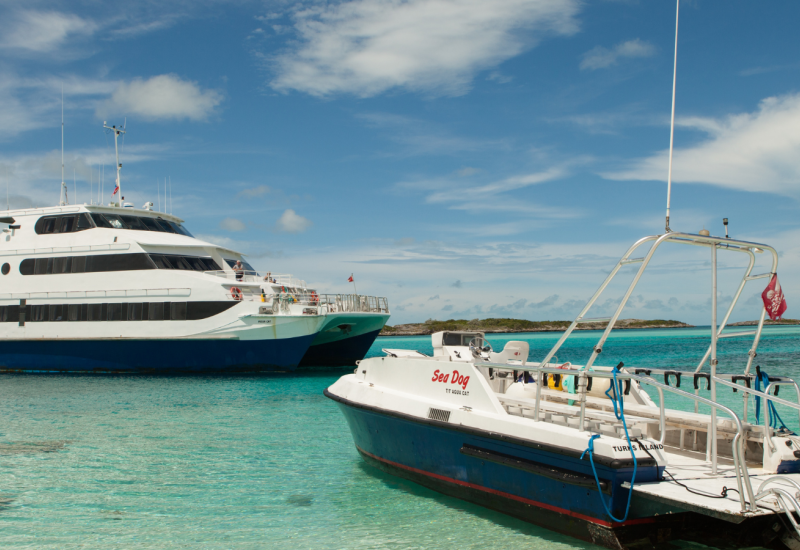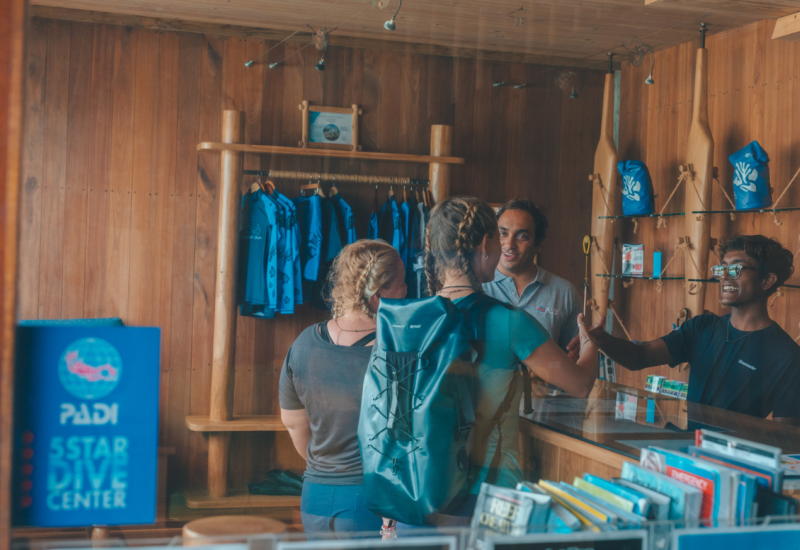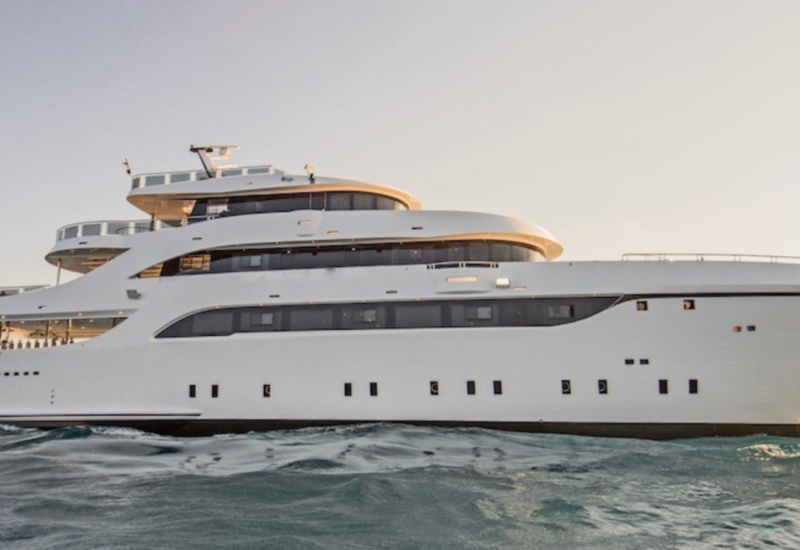Diving Mexico's Sea of Cortez
The landscape is a haunting one, at once forbidding and romantic in a way that seizes your heart and fires your imagination.
Baja California is an ancient land: The long spire that stretches nearly 1,000 miles from Tijuana to Cabo San Lucas broke off the Mexican mainland millions of years ago and is still on the move, inching toward San Francisco. Mexicans recognized this land of sea and desert — where fantastical formations in sandstone and granite are reflected underwater — as a precious place long ago. Today they are working to preserve it as a truly wild place that co-exists with rapidly encroaching civilization: LAX is only two hours from La Paz, 100 miles up the peninsula from better-known Cabo San Lucas and San Jose del Cabo, which are merging into a tourist megalopolis to the south.
For now La Paz retains its splendid isolation; today the Sea of Cortez is a place where encountering hammerheads, sea lions, mobula rays, wild dolphins and whale sharks — all in just a few days’ diving — is commonplace.
“When I started diving El Bajo in the 1980s, you didn’t have to go looking for the sharks,” says Lorenzo Beltran, 47, manager of La Paz-based live-aboard M/V Valentina, referring to the hammerhead aggregations for which Cortez is famous. In the intervening years, overfishing had severely impacted the area, but a marine park established about five years ago has worked miracles.
“In just that time, it’s amazing the way it has come back,” Beltran says. “The Sea of Cortez is still pristine. We started protecting it just in time. Local divers and fishermen really understand we have to protect for the future. I have a lot of faith it’s going to be back like the ’80s.”
At El Bajo we descend in semidarkness through blue-white pinpricks of fluorescence that seem to wink out as the morning light grows. Visibility is a startling 80 to 90 feet, and every diver has his or her eyes trained on the blue, straining for the telltale T-bone shapes.

Courtesy Fun AzulM/V Valentina is in the Sea of Cortez August to November.
Seen in photos, hammerheads seem awkward, unlikely creatures. But observing dozens at a time — including a river of 24 or more that passes directly below us — they are the sexiest, curviest animals ever. Hundreds more congregate at the bottom, well below where we hover at 90 feet or so.
When our time is up, we surface to a giant Ansel Adams moon hanging over blue-black mountains kissed by the advancing dawn.
“Welcome to the Sea of Cortez,” Beltran says.
Cortez Dive Guide All dive operators are really in the fairy-tale business: Show me the unicorn, or I want my money back! But in the Sea of Cortez, the unicorns really do show up quite reliably.

Mark Conlin/CorbisHammerhead sharks are almost guaranteed at Sea of Cortez sites like El Bajo.
After two hammer-packed dives at El Bajo, we came up empty on our third attempt. Not wanting to be greedy, we were trying to conceal our disappointment when suddenly two pods of dolphins — a small group of bottlenose and a much larger one of common dolphins — materialized around the RIBs. Instantly, we were back in the water — a merry chase ensued, with snorkeling divers shrieking and laughing, and tolerant dolphins keeping just enough distance to egg us on.
That’s how it is in the Sea of Cortez: You don’t want to look away for a second. Go to Valentina’s salon for coffee and you’ll hear, “Baby hammerhead out here!” Slip back to your cabin for more sunscreen and someone hollers, “Sperm whale!” The action is nonstop.
Nowhere is that better illustrated than at Los Islotes. This sea lion rookery offers multiple sites in one, allowing Valentina to spend about a day and a half here.

Norbert Wu/Minden PicturesWhale shark are present year-round in La Paz Bay, Sea of Cortez.
“There are sea lions all over, but not like the Sea of Cortez,” Beltran, a La Paz native, says with pride. “They wait for you to come play. The babies learn to play with divers, and the mothers are fine with it.”
On the site’s north side, opposite the nursery, we dropped straight down to 110 feet or so to pay a call on a colony of resident jawfish, which zoomed back into their perfect-circle burrows as soon as they saw us. Hanging above them was the biggest school of barracuda I had ever seen. Stretching from the seafloor to halfway to the surface or higher, thousands of fish were herded by half a dozen huge grouper, including a neon leopard grouper in its golden phase.

Danita Delimont/Getty ImagesMexico's Cortez is a narrow sea; divers are rarely out of view of its dramatic coastline.
Passing through a ravine below a dramatic topside arch, we came to a rocky arena where the day’s sea lion rodeo was in progress — just pick a rock, take a seat, and enjoy the show.(If your tender captain offers you a bit of rope, take it — the younger sea lions will play with it, and you, for what seems like hours.)
Playgrounds like Los Islotes might account for the impression that Valentina’s staff is having as much fun as you are. The superfriendly international crew — who all speak multiple languages — puts safety first, but fun is a close second.
The comfortable, spacious, 130-foot ship, which started life as a cruise ship and has been substantially renovated for divers, never feels crowded, with more than enough space for its 20 passengers to spread out across its three main decks and 10 cabins.
Menus emphasize seafood and traditional Mexican specialties prepared with fresh, healthful ingredients. “It’s not food — it’s cuisine,” marvels Carine Logvinoff, 41, a Frenchwoman from Toronto. “The quality of the food is amazing.”

Luis Javier Sandoval/Getty ImagesThe friendly, playful sea lions at the famed Los Islotes dive site will give you hours of joy underwater.
A diver since 1996, Logvinoff was making her second trip to the Sea of Cortez because “you will see things you can’t see elsewhere,” like sea lions and jaw-droppingly huge baitballs found so consistently and in such predictable locations that local divers refer to them like old friends.
Logvinoff chose Valentina because “they make it easy,” and was loving it because “everyone is really, really smiley,” she said with a laugh.
Those smiles are evident right up until the last moments of the trip.

Brandon ColeGiant Mexican hawkfish are common in the Sea of Cortez.

James D. Watt/SeaPicsGargantuan baitballs are common in Mexico's Sea of Cortez.
You would never have guessed, as you sipped your cerveza on the La Paz waterfront and gazed out at the huge bay, that here be whale sharks, right in front of you. On the last day of the cruise, Valentina enters the bay but stands off from port while crew members in RIBs crisscross the area, searching for whale sharks. Some days they find multiples, but they almost always encounter at least one, the signal for the RIBs to ferry eager snorkelers from Valentina to wherever the whale sharks are.

Michael S. Nolan/SeaPicsValentina offers a mobula night dive (they are also seen in daytime).

Christopher Swann/CorbisDolphins can appear anytime in Mexico's Sea of Cortez.

Mary Frances EmmonsCosta Baja Resort, where M/V Valentina departs, is a dramatic makeover and expansion of an older La Paz, Mexico, resort.
Captains and spotters take turns positioning craft on the whale sharks’ heading: Snorkelers enter the water on cue and wait for the behemoths to glide serenely beneath — and then swim like mad to try to catch a longer glimpse. Then the snorkelers climb back aboard and do it all over again, half a dozen jumps or more, depending on the day and the whale sharks. It’s a workout, but among the most fun ones you’ve ever had, guaranteed — and a perfect finish to a magical voyage.

Mary Frances EmmonsIconic creatures seem to swoop across the open-air lobby of the Costa Baja Resort in La Paz, Mexico.

Courtesy Costabajaresort.comFine-dining options abound at Costa Baja Resort in La Paz, Mexico, home port to the M/V Valentina liveaboard.
Need to Know When to Go The Sea of Cortez can be a completely different place -depending on the season. Its sea lions and whale sharks are present year-round; various types of migrating whales mate and calve here in winter months; you also may see more sharks and other pelagics in colder months. (Valentina is in the Sea of Cortez August to -November; from November to June, it is in the Socorro Islands.)

Courtesy Costa Baja ResortLocated five miles from central La Paz, Costa Baja Resort is surrounded by a beach club and fine-dining restaurants, among other amenities.

Courtesy Costabajaresort.comSunsets are consistently spectacular over the Sea of Cortez.
Dive Conditions The most comfortable months are August to early November, with calm seas and water temps in the 80s. (I dived in October in a bathing suit and 1 mm vest.) In winter, temps can drop to the high 60s, when a 5 mm fullsuit and hooded vest is needed, and conditions can be rougher.

Courtesy Costabajaresort.comLa Paz is a charming, traditional Mexican seaside town. Don't miss a stroll along its sculpture-lined 3-mile malcon, or sea walk.

Courtesy Costabajaresort.comA scene from La Paz, on the shores of the Sea of Cortez.

Courtesy Costabajaresort.comThe Sea of Cortez gives you the chance to dive with hammerhead sharks, mobula rays, dolphins, sea lions and whale sharks.

Mary Frances EmmonsM/V Valentina's lounge — handy to its bar — occupies a comfortable corner of the dining salon.
Operator Valentina is part of the Fun Azul Fleet (fun-azulfleet.net), in conjunction with -popular La Paz dive shop Fun Baja (funbaja.com), which also operates seven day boats there. The 130-foot ship with a generous 30-foot beam accommodates 20 passengers in 10 cabins.
Price Tag A five-night Sea of Cortez cruise with three to four dives daily starts at $2,190.

Mary Frances EmmonsM/V Valentina's dive deck includes an enormous camera table as well as room for tanks, wetsuits and assorted scuba diving gear.

Mary Frances EmmonsM/V _Valentina'_s upper deck includes its dining salon and ample outdoor areas, with lounges for sunning as well as shaded tables and chairs.

Mary Frances EmmonsM/V Valentina's sun deck is usually a quiet spot to catch some rays, except when it doubles as an open-air dining room on select evenings.

Courtesy fun-azulfleet.netM/V Valentina's cuisine features fresh, healthful ingredients, with an emphasis on seafood and Mexican specialities.
La Paz Guide Divers boarding MV Valentina should plan to arrive early in La Paz. The town is worth exploring, particularly in the evening, when its malecon, or sea walk, comes alive with tourists and locals enjoying the many bars and restaurants along its 3-mile length. The malecon also is worth a stroll for its collection of sculpture that mostly pays homage to the sea, in particular a whimsical representation of Jacques Cousteau, who helped put this area on the map when he declared the Sea of Cortez to be “the aquarium of the world,” a designation locals embrace with pride.

Courtesy fun-azulfleet.netCabins accommodate a total of 20 passengers aboard M/V Valentina. Cabins are accessed from the main deck.

Courtesy fun-azulfleet.netAll cabins aboard M/V Valentina have air conditioning and newly renovated ensuite bathrooms.
MV Valentina requires its guests to stay the night after disembarking, because the whale-shark hunt executed just before its return to port can end at varying times, depending on how easy or difficult the animals are to locate. Here are a couple of suggestions:

Mary Frances EmmonsSea lion pups will swim out from the rookery at Los Islotes dive site to greet divers in tenders.

Mary Frances EmmonsA bull sea lion reigns over his harem at Los Islotes dive site, one of the most popular stops on the M/V Valentina's Sea of Cortez itinerary.
Costa Baja Resort
Five miles from central La Paz, Costa Baja Resort is a startlingly beautiful modernization of an older resort, surrounded by new additions including fine-dining restaurants, a beach club with gorgeous infinity pool, a hill-top golf course and club overlooking private luxury villas, and the full-service marina where you’ll board Valentina. The mostly bilingual staff is highly trained, and service is excellent. Rooms are ultra modern and huge, with ingenious glass-walled showers built into the main room (frosted glass provides privacy). The premier restaurant on property, Steinbeck’s, honors the author whose _The Log from the Sea of Cortez_ was inspired by his travels in Baja in 1940 — the tasting menu, paired with Mexican wines, is a revelation. A free shuttle runs from the resort to the town center, or a cab costs about $10 each way. Costabajaresort.com

Mary Frances EmmonsFemale sea lions may appear relaxed, but they keep a close eye on their pups at Los Islotes dive site in the Sea of Cortez. As long as divers are cautious and respectful, mama sea lions have no problem allowing their pups to play with visiting scuba divers and snorkelers.

Courtesy fun-azulfleet.netIt's a miniature stingray that thinks it's a manta: Mobula rays are the focus of a fun and unique night dive staged by M/V Valentina crew in a secluded bay with a white-sand bottom perfect for kneeling to watch the nonstop action.

Courtesy fun-azulfleet.netThe sea lions of Los Islotes are just one of the Big Five in the Sea of Cortez: Whale sharks, hammerhead sharks, dolphins, mobula rays and sea lions.
Cortez Club Divers
Many of the best sites visited by MV Valentina also are accessible by La Paz-based operators; warm-up with a day of diving with Cortez Club. The dive shop is located less than 2 miles from Costa Baja Resort, and can get you to sites like La Reina, where you’ll get your first taste of diving with sea lions as well as a view of baitballs as massive as any on earth — don’t be surprised if dozens of common dolphins accompany you on your way out or back. Bring cash to enjoy an après-dive drink at Cortez Club’s seaside palapa, the Sunset Bar. It’s the perfect place to relax and relive your day. cortezclub.com

Mary Frances EmmonsM/V Valentina's sister operation, Fun Baja, offers three scuba diving camping adventures on the stunning protected island of Espíritu Santo.

Mary Frances EmmonsEspíritu Santo, where you can scuba camp, is a UNESCO biosphere reserve.

Mary Frances EmmonsCamp stools in the mess tent at Espiritu Santo are made from dried cactus trunks.
FOUR TIPS TO MAKE YOUR VALENTINA TRIP BETTER
1. iPads are the common tongue.Valentina attracts clientele from Japan and Europe as well as the United States. Load pictures of your family, house, pets and hometown onto your tablet — these icebreakers establish an instant connection when language is a barrier.

Mary Frances EmmonsTasty pitahaya fruit, beloved of Baja's children once shorn of its thorns, is somewhat similar to watermelon in texture.

Courtesy fun-azulfleet.netEnormous bait balls are a hallmark of Mexico's Sea of Cortez.
2. Learn a few words. Ask your Valentina rep what nationalities will be aboard during your trip, and learn a few phrases like “good morning” or “thank you” before you go. If nothing else, amusement at your attempts might spark new friendships.
3. Double your sunscreen. It’s a desert! It’s an ocean! It’s a desert! Cortez is both, and can be hotter and drier than you expect. Select a high SPF, and re-apply regularly. Seek shade — or Valentina’s air-conditioned salon — in the hottest parts of the day.

Courtesy fun-azulfleet.netSchooling jacks provide nonstop action for divers in Mexico's Sea of Cortez.

Courtesy fun-azulfleet.netSnorkeling with whale sharks in La Paz bay caps your liveaboard adventure aboard the M/V Valentina in the Sea of Cortez.
4. Weighty matters. Cortez is a salty sea; don’t be surprised if you’re bobbing like a cork at first. Add more weight than you think you need — especially if you are using a heavier exposure suit in colder months — until you have a dive or two under your belt.










